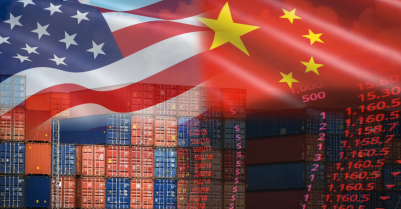Macroeconomic Scenario for 2021-2022: a (very) disorderly exit from the crisis
While the United States prepares to take a generous lead, the Eurozone, where each country seems to be heading down its own path to recovery, is lagging behind, and fragmentation continues in emerging markets. The Fed looks on serenely as long-term interest rates rise, but the ECB seems more concerned. Once the inflationary push dissipates, accommodating monetary policy does leave room for a less ‘disordered’ and more gradual increase in long-term rates, regardless of any ‘reflation trade’.

While the United States prepares to take a generous lead, the Eurozone, where each country is headed down its own path to recovery, lags behind. The path of the pandemic, progress of vaccination programmes, and the scale of government support for activity continue to drive growth forecasts.
Boosted by the adoption of a massive recovery package and progress on vaccinations, US growth could reach 5.1% in 2021 and 3.8% in 2022. If households spend a more substantial portion than expected of their forced savings, consumption and growth could exceed our projections which, moreover, do not include the impact of the Biden administration’s infrastructure investment plan, which could boost the growth outlook, albeit not until 2022. Our Eurozone scenario, based on a downward revision in the first half of the year caused by the pandemic’s damage, followed by a rebound in the summer, assumes more modest growth (4%) for 2021 as well as 2022 (4.1%). The growth differential between the Eurozone and the other major advanced economies is widening, and intrazone fragmentation persists. France and Germany should return to pre-crisis GDP by mid-2022; Italy and Spain are likely to still fall short at the end of 2022.
However, if there is any clear line of demarcation, it is the one separating the developed countries from the emerging world, in which the fragmentation trend is asserting itself. Thanks to unprecedented measures taken by the authorities, the IMF[1] estimates that the aftermath of the recession brought about by the Covid-19 crisis should be less severe in the advanced economies than in the wake of the 2008 global financial crisis. These repercussions are not fully visible as they remain heavily obscured by the support plans. The IMF, on the other hand, is predicting that the harder-hit emerging countries are likely to suffer greater losses in the medium term. On top of structural weaknesses (including reduced – and now largely exhausted – leeway) lie external constraints which, from the trend in US interest rates to the uncertainties on resumed tourist flows, are continually highlighting this peculiar fragility, and may work against the recovery.
Inflation “is a concern”: in fact, it is rising due to the combination of a base effect and increasing oil prices. However, this has more to do with an undeniably strong but temporary push than with some lead-up to a powerful and lasting comeback. It is missing the key ingredient of powerful wage acceleration, to which the backdrop is still not conducive.
While calling for prudence given so much uncertainty, the trend in the output gap[2] indicates how fast surplus capacity is being absorbed. Many large Western economies took nearly nine years to fill the sinkhole of excess supply dating back to the end of the financial crisis in 2009. Not until 2019 did the major countries, Italy aside, post neutral (France and the United Kingdom) or positive (Germany and the United States) output gaps. According to the IMF, at the end of 2022, only the US will be trending above its potential, but its unemployment rate will still exceed pre-crisis levels (4.2% vs. 3.7%). In addition, during the lengthy post-2008 recovery, even in countries that had managed to enjoy a substantial drop (lagging behind the business improvement) in unemployment (in 2019 unemployment was 3.2% in Germany, 3.8% in the UK, and 3.7% in the US), inflation never soared (ranging from 1.5-2.1%). Lastly, while annual growth in unit labour costs rose at the end of the period (as much as 2.3% and 2.1% in the UK and US, respectively, in 2019), this isolated ‘runaway’ coincided with the end of the very strong growth cycle. In the OECD, the rise in unit wage costs stood at an annual average of 1.2% between 2010 and 2018, culminating at 2.4% before the shock of 2020.
Obviously, this is a backward-looking and incomplete overview, but it does illustrate the “flattening of the Phillips curve”, behind which structural factors lurk justifying the slightest push that wages can get from a decline in the unemployment rate, including globalisation, automation, the rise of the service economy, ‘uberisation’, and the erosion of employees’ negotiating power. This cropped picture means that we can count on consumer prices softening once the temporary push is over. However, this does not dispel the risk of an “impression of returning inflation”, which itself will continue to fuel the theme of reflation.
Fuelled by the scale of the fiscal stimulus plans, the prospects for sustained growth in the United States, fears of supply saturation due to Covid-19, and the idea of a new upward cycle in commodity prices, the theme of reflation has significantly increased US long-term interest rates. Unmoved by this rebound that is seen as a sign of confidence, the Federal Reserve is maintaining its accommodating stance, and has said it will stay there for an extended period despite the improved economic outlook and future inflation peaks.
Deaf even to the Fed’s very accommodating tone, US long-term yields continued their comeback, dragging European (and other) yields in their wake. More concerned by an untimely tightening of financial conditions, the ECB doubled down on its quantitative easing, and could find itself forced to “do more”: more communication, more support. Once the inflationary push dies out, monetary easing promises a less “disordered” and more gradual rise in long-term interest rates (our outlook includes US and German sovereign rates at 1.75% and -0.20%, respectively, in late 2021), regardless of any reflation trade. Finally, boosted by US performance, with the forecast of a strong recovery pushing bond yields upward, the USD is attractive. Beyond its obvious but temporary advantage, it should return to its long-term downtrend, though this could be interrupted by a possible escalation in trade tensions between the US and China.
Consult our publication: World – Macroeconomic Scenario for 2021-2022: a (very) disorderly exit from the crisis –13 April 2021
Catherine LEBOUGRE – Catherine.lebougre@credit-agricole-sa.fr
[1] World Economic Outlook, April 2021
[2] Output gap expressed as a % of potential GDP (IMF, World Economic Outlook Database, April 2021).









